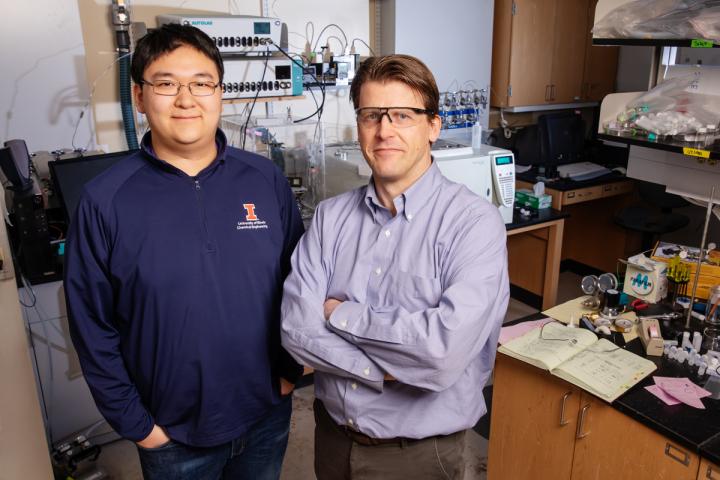
Credit: Photo by L. Brian Stauffer
CHAMPAIGN, Ill. — Surplus industrial carbon dioxide creates an opportunity to convert waste into a valuable commodity. Excess CO2 can be a feedstock for chemicals typically derived from fossil fuels, but the process is energy-intensive and expensive. University of Illinois chemical engineers have assessed the technical and economic feasibility of a new electrolysis technology that uses a cheap biofuel byproduct to reduce the energy consumption of the waste-to-value process by 53 percent.
The new findings are published in the journal Nature Energy.
Conversion of CO2 to chemicals like ethylene for plastics is possible through a process called electrochemical reduction. Typically, a stream of CO2 gas and a fluid electrolyte move through an electrolysis cell that breaks the CO2 down into molecules like ethylene on the cathode, but it also produces oxygen from water on the anode, the researchers said.
“About 90 percent of the energy required in conventional CO2 reduction is used up by the oxygen-producing, anode side of an electrolysis cell,” said Paul Kenis, a chemical and biomolecular engineering professor, department chair and study co-author. “But there is no big market for the excess oxygen, so 90 percent of the energy is essentially wasted.”
Finding a feed material that reduces the energy to drive the anode reaction could be a strategy for radically reducing the energy requirements of CO2 conversion, according to a recent National Academies Report of which Kenis was a co-author.
The new study proposes glycerol – an organic byproduct of sugar cane biofuel production that requires less energy to oxidize – as an alternative to the energy-intensive oxygen-producing step.
To test if the new electrolysis technique has the potential to push the full CO2 conversion process to a carbon neutral or negative budget, the researchers examined the cost and energy consumption for the production cycle of the waste-to-value process. The four-step cycle includes the capture of industrial CO2 waste gas, the input of electricity, the new
“Our model uses the current electrical grid setup as the source of electricity to make the scenario more realistic,” Kenis said. “Being able to drive CO2 conversion with already-in-place infrastructure – and not relying on the hope of the future grid being powered by 100 percent renewables – while achieving carbon neutrality or negativity could be a holy grail scenario.”
The analysis includes best- and worst-case CO2 emissions and energy consumption scenarios and concludes that the prospects of CO2 reduction, in terms of CO2 emissions and economics, can drastically improve by looking beyond conventional anode reactions.
“The glycerol-based electrolysis reaction shows a lot of promise. However, we will continue to explore other organic waste materials because even when production rises in the wake of increased biofuel production, it still will not be enough to fully support the need,” Kenis said. “The good news is that the chemistry involved is flexible and there are a lot of organic waste products that can do the job.”
Many researchers focus on improving the selectivity and activity of chemical catalysts for CO2 reduction reactions, and that work needs to continue, said Sumit Verma, a former chemical and biomolecular engineering graduate student and study co-author. “Looking beyond oxygen evolution at the anode seems like a win-win situation, as we not only reduce the processes’ energy consumption but also produce a second valuable product stream,” he said.
###
The International Institute for Carbon Neutral Energy Research; Japanese Ministry of Education, Culture, Sports, Science and Technology; Dow Chemical Company; and the Glenn E. and Barbara R. Ullyot graduate fellowship supported this research.
Editor’s notes:
To reach Paul Kenis, call 217-625-0523; [email protected].
The paper “Co-electrolysis of CO2 and glycerol as a pathway to carbon chemicals with improved technoeconomics due to low electricity consumption” is available online and from the U. of I. News Bureau. DOI: 10.1038/s41560-019-0374-6
Media Contact
Lois Yoksoulian
[email protected]
Original Source
https:/
Related Journal Article
http://dx.




